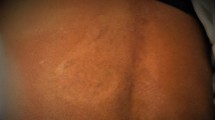Abstract
A 37-year-old man presented to the emergency department with left flank pain and vomiting. Bedside ultrasound performed by the treating emergency physician revealed left-sided hydronephrosis and perinephric fluid, suggesting a rupture of the renal pelvis. Urinary sonography revealed an absent left ureteral jet, suggesting left ureteral obstruction. Treatment was initiated and a non-contrast computed tomography scan confirmed the initial ultrasound findings.
Similar content being viewed by others
Case report
A 37-year-old man with no prior medical history presented to the emergency department (ED) 4 h after the onset of acute left flank pain and vomiting. He denied fever, diarrhea, dysuria, or trauma. His temperature was 98.2°F, pulse 104/min, respirations 18/min, blood pressure 142/78 mm Hg, and his room air oxygen saturation was 98%. His physical examination was remarkable for left costovertebral angle tenderness. His abdomen was soft and non-tender without rebound or guarding. A mid-stream urinalysis showed 0–2 red blood cells/high powered field.
The treating emergency physician performed a bedside ultrasound using a 5–2 MHz curvilinear transducer (Sonosite M-Turbo, Bothell WA). Examination of the left kidney demonstrated moderate hydronephrosis and an anechoic fluid collection surrounding the left kidney consistent with a calyceal rupture and pyelosinus extravasation (Fig. 1; h = hydronephrosis, asterisks = fluid collection, and Video Clip S1, available as supporting information in the online version of this paper). Although power Doppler examination of the bladder demonstrated a ureteral jet from the right ureteral orifice (Fig. 2), no ureteral jet was visible on the patient’s left, indicating a left ureteral obstruction.
Results and discussion
Non-contrast computed tomography (CT) scan of the abdomen and pelvis confirmed a 5 mm obstructing left ureterovesical junction (UVJ) stone (Fig. 3; b = bladder, asterisk = stone) with left-sided hydronephrosis and perinephric fluid (Fig. 4; h = hydronephrosis, asterisk = perinephric fluid). The patient was evaluated by an urologist after his symptoms were controlled with antiemetics, analgesics, and intravenous crystalloid. He was discharged home with oral antibiotics and opiate analgesics, an alpha 2-antagonist, and a follow-up appointment in the urology clinic 48 h later. Chart review revealed that the patient recovered uneventfully without any surgical intervention.
Rupture of the renal pelvis with extravasation of urine into the perinephric and/or retroperitoneal space is a rare condition most often resulting from trauma [1], but also associated with obstructing ureteral calculi, or compression of the ureter by pregnancy [2], tumor or retroperitoneal fibrosis [3]. Flank and abdominal pain are the most common presenting symptoms, and ultrasonography and computed tomography (CT) are the initial diagnostic modalities of choice. Serial ultrasound exams may demonstrate enlargement of the perinephric fluid collection [4] that may prompt urologic intervention. Symptoms can also be relatively mild, however, and as in our case, resolve without the need for urgent urologic intervention.
Patients with flank and upper abdominal pain have a broad differential diagnosis, including many life-threatening entities, such as acute cholecystitis, pancreatitis, intestinal obstruction, mesenteric ischemia, aortic dissection, and aortic aneurysm. The ability to rapidly diagnose a rupture of the renal collecting system using point-of-care sonography can be of great assistance in the evaluation of these patients, and can affect the choice of subsequent diagnostic and therapeutic strategies.
References
Ashebu SD, Dahniya MH, Aduh P et al (2004) Rupture of the renal pelvis of a ureteropelvic junction hydronephrosis after blunt abdominal trauma. Australas Radiol 48:256–258
Van Winter JT, Ogburn PL, Engen ED et al (1991) Spontaneous renal rupture during pregnancy. Mayo Clin Proc 66:179–182
Ashebu SD, Elshebiny YH, Dahniya MH (2000) Spontaneous rupture of the renal pelvis. Australas Radiol 44(1):125–127
Koktener A, Unal D, Dilmen G et al (2007) Spontaneous rupture of the renal pelvis caused by calculus: a case report. J Emerg Med 33(2):127–129 Epub 2007 Jun 5
Conflict of interest
None.
Author information
Authors and Affiliations
Corresponding author
Electronic supplementary material
Below is the link to the electronic supplementary material.
Supplementary material 1 (mov 2132 kb)
Rights and permissions
Open Access This article is distributed under the terms of the Creative Commons Attribution 2.0 International License ( https://creativecommons.org/licenses/by/2.0 ), which permits unrestricted use, distribution, and reproduction in any medium, provided the original work is properly cited.
About this article
Cite this article
Stone, M.B., Secko, M.A. Spontaneous rupture of the renal pelvis due to an obstructing ureteral calculus diagnosed by point-of-care ultrasound. Crit Ultrasound J 1, 133–134 (2010). https://doi.org/10.1007/s13089-009-0019-2
Received:
Accepted:
Published:
Issue Date:
DOI: https://doi.org/10.1007/s13089-009-0019-2








